It’s pretty obvious that LEDs are hot, and we’re not talking about thermal characteristics. The industry is producing improved LEDs just about every month, and they are moving into new applications at a record clip. The products described here more than validate these trends.
White LEDs
Offered as a low-power alternative to conventional, residential, and industrial lighting, the TL12W01-D white surface-mount LED from Toshiba America Electronic Components (www.toshiba.com/taec) provides a typical 30-lm flux of from a 250-mA driving current. Measuring 10.5 x 5.0 x 2.1 mm, it also targets space-limited applications requiring high-brightness LCD backlighting.
The SMD delivers typical 35 lm/W with a low-thermal-resistance package that improves heat release. Forward voltage for the Pb-free device is rated at 3.4 V typ at a forward current of 250 mA, and its operating range is −40° to 100°C.
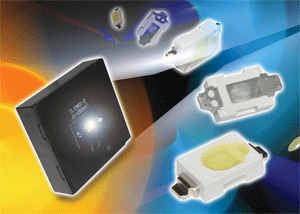
Toshiba TL12W01-D white surface-mount LED
Toshiba’s TLWK1100B LEDs are said to provide twice the brightness of the company’s previous-generation devices are among the brightest white LEDs in the industry. They deliver luminous intensity levels of 1,500 mcd from a drive current of only 20 mA typ and are available in a standard 3.2 x 2.9 x 1.9-mm PLCC2 surface-mount package.
The LED’s high-brightness white-light output is a result of a combination of a blue InGaN LED and yellow-emitting phosphor. Operating temperature ranges from 40° to 100°C. The design suits the device for use in automotive lighting designs, as LCD backlighting, in panel indicators, and as a replacement for incandescent bulbs in appropriate lighting applications.
The UNO neutral-white-LED array from Enfis (www.enfis.com) produces an output of 1,365 lumens from an emitting area of just 0.5 cm2. The powerful point source can be manipulated optically to provide a range of lighting solutions.
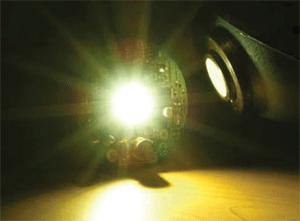
Enfis UNO neutral-white-LED array
The array will be available both as a stand-alone unit and in light engines with fully integrated electronic and thermal management.
Color LEDs
Producing a maximum luminous flux of 42 lumens at 350 mA, the blue-emitting XLamp XR-E LED from Cree (www.cree.com) is 70% brighter than the previous device generation. The blue LEDs offer lighting designers increased flexibility to now choose to use fewer LEDs to lower the overall design cost or use the same number of LEDs to achieve greater light output.

Cree XR-E blue LED
Visible in direct sunlight, Ledtronics’ (www.ledtronics.com) LD200-0AG-15D aqua green LED delivers an output of 28,000 mcd with an input of 20 mA. The 5-mm (T1¾) 525-nm InGaN device comes with a water-clear lens with has a viewing angle of 15º.
Ledtronics also offers the RGB-1007-001 low-profile RGB LED , which emits light at wavelengths of 635, 520, and 470 nm in a viewing angle of 120°. Depending on color, the full-spectrum device’s luminous intensity ranges from 230 to 750 mcd when powered from a 20 to 25-mA source, which suits it for use with handheld and mobile devices as well as other systems.
oprc03_sep2007
Ledtronics RGB-1007-001
The four-lead through-hole device has a diameter of 5 mm and an above-board height of 2.9 mm. A water-clear lens protects the diode array, and the LED can be used with light pipes to move light between a printed-circuit board and remote indicator-illumination points.
Featuring an internal circuit board with a reconfigurable signal interface for maximum deployment flexibility, the SHA Series multiple-tier LED indicator stacks from Bivar (www.bivar.com) are available in versions providing from four to eight tiers. Available with a variety of single- and dual-color emitters from 430 to 655 nm, the devices offer water-clear, diffused, or tinted lenses based on color selections, with viewing angles that range from 30° to 45° (± 0.5°).

Bivar SHA series
The 4.3-mm-wide SMT indicator is 21.8 mm deep and has emitter centers 5.1 mm apart, and an eight-LED stack is 41.1 mm high. An included SMT card-edge connector enables pick-and-place assembly in production lines.
Designed specifically for high current applications, the OVSPRGBCR4 wide-angle RGB LED from OPTEK Technology (www.optekinc.com/products/VLED_smd.asp) has individually addressable emitters in an SMT package with a viewing angle of 130°. The forward current of the 6 x 6 x 1.5-mm device is 250 mA for each color with a peak pulsed current of 500 mA.
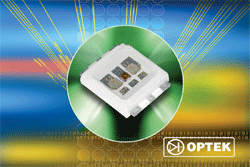
OPTEK Technology OVSPRGBCR4 wide-angle RGB LED
Typical luminous flux for the red, green, and blue LEDs is 21, 32, and 7.5 lumens with a typical on-axis intensity of 7, 11, and 2.8 cd, respectively. The maximum rated junction temperature is 125°C, while the operating temperature can range anywhere from –40° to 100°C.
Lamp replacements
Providing a smaller and more efficient replacement for the xenon lights used in small digital cameras and camera phones, the FCW211Z Series LED photoflash lamp from Seoul Semiconductor (www.zled.com) delivers up to 100 cd at 2 A and can provide a flash with a light energy of 26.49 lux/s. In addition to being smaller at 3.5 x 3.0 x 0.75-mm, the SMT device also has an operating lifetime up to twice that of xenon lamps.

Seoul Semiconductor FCW211Z LED photoflash lamp
Another major advantage to LED flash over xenon is the ability to take pictures faster with shorter intervals as an LED does not require a charge capacitor to operate as a xenon bulb.
Using driver electronics compatible with most ballasts, the EverLED TR LED-based white tube light from LEDdynamics (www.everled.com) is a drop-in replacement for fluorescent lamps in standard T8, T10, and T12 fixtures. The 48-in. T8 replacement provides the equivalent light output of a 40-W tube while consuming only 25 W.
Available in five color temperatures from 2,900K to 6,500K, the lights have no glass, phosphor, lead, or mercury and consume up to 20% less power than fluorescent devices. The flicker-free LED tubes have a directed light output, which can improve efficiency by significantly reducing reflector loss, and are available with options including infrared or RF remote control, adjustable color temperature, and automatic ambient-light adjustment.
Designed to replace conventional halogen point-sources as well as fiber-optic illumination solutions, a family of LED spot projectors from StockerYale (www.stockeryale.com) is well suited for use in machine vision, microscopy, and biomedical applications.
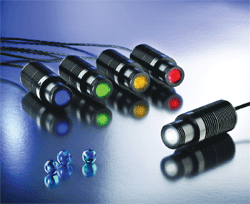
StockerYale LED spot projectors
Available in a wide range of wavelengths including red, blue, green, amber, and broadband white, the LED projectors have divergence angles of 10 or 25°, and the units are also available optionally in a fiber-coupled configuration.
With standard 25-mm Edison bases, R30 LED Reflector low-power spotlight bulbs from Ledtronics (www.ledtronics.com) can directly replace 120-Vac 65-W incandescents. The bulbs draw only 4.5 W and are available with a choice of five light-emitting angles (15°, 20°, 30°, 40°, and 95°), and in 12 to 240 Vac or dc versions as well as 120 Vac.

Ledtronic R30 Reflector low-power spotlight bulbs
Visible-light bulbs are available in warm white (3,000K), pure white (5,500K), cool white (8,000K), red (633 nm), yellow (592 nm), aqua-green (525 nm), and blue (470 nm). Infrared lamps are offered in wavelengths of 850, 880, and 940 nm.
Providing total flexibility to design a four-chip LED configuration to suit specific lighting needs, the ACULED DYO four-LED array from PerkinElmer Optoelectronics (www.optoelectronics.perkinelmer.com) comes with a choice of components that include sensors and ESD protection chips as well as visible and nonvisible emitters.
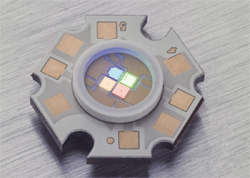
PerkinElmer Optoelectronics ACULED DYO four-LED array
The completely configurable LED array addresses applications in general illumination as well as specialty areas like architectural, automotive, entertainment, mood, display, and medical lighting.
Designed for front-panel mounting in 12- and 16-mm holes with panel thicknesses of up to 6.3 mm, a family of LED indicators are available from Dialight (www.dialight.com) in versions providing up to 60 mcd in red, 110 mcd in green, and 90 mcd in yellow. The RoHS-compliant devices operate from an input of 15 mA at 6, 12, or 24 Vdc.

Dialight indicator lamps
The LED indicators do not require the addition of limiting resistors and their operating temperature can range from 25 to 85C.
Richard Comerford
Advertisement
Learn more about Electronic Products Magazine





